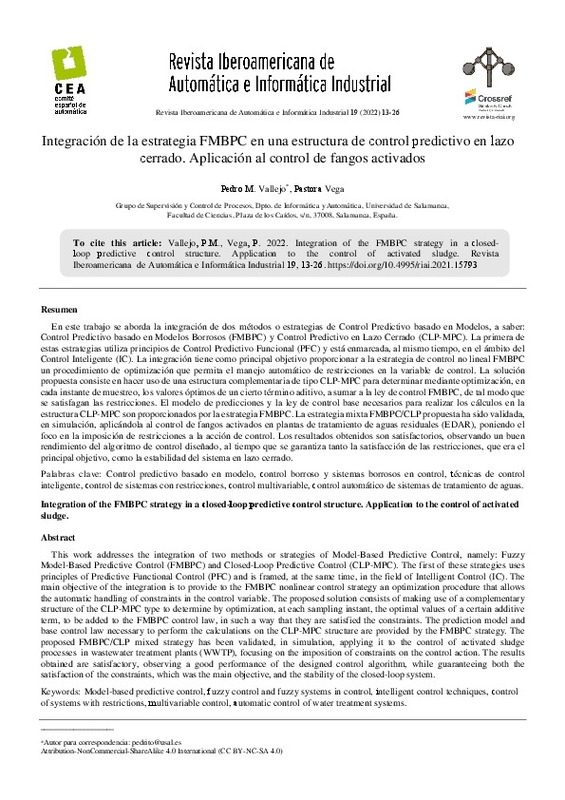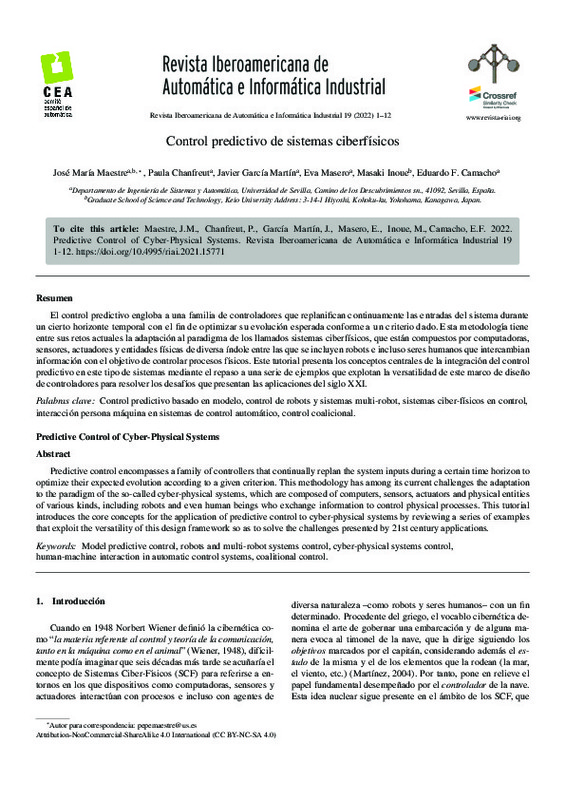JavaScript is disabled for your browser. Some features of this site may not work without it.
Buscar en RiuNet
Listar
Mi cuenta
Estadísticas
Ayuda RiuNet
Admin. UPV
Evaluación del desempeño por apuntamiento de estrategias de control para seguidores solares fotovoltaicos de alta concentración
Mostrar el registro sencillo del ítem
Ficheros en el ítem
| dc.contributor.author | Garrido Satué, Manuel
|
es_ES |
| dc.contributor.author | Castaño Castaño, Fernando
|
es_ES |
| dc.contributor.author | Ortega Linares, Manuel Gil
|
es_ES |
| dc.contributor.author | Rodríguez Rubio, Francisco
|
es_ES |
| dc.date.accessioned | 2022-05-24T07:56:37Z | |
| dc.date.available | 2022-05-24T07:56:37Z | |
| dc.date.issued | 2022-04-01 | |
| dc.identifier.issn | 1697-7912 | |
| dc.identifier.uri | http://hdl.handle.net/10251/182823 | |
| dc.description.abstract | [EN] In this article the pointing performance of several control strategies for high concentration sun trackers is evaluated. Due to the high accuracy required in real pointing, below the global acceptance half-angle of the energy harvesting system, the article sumarizes the most characteristic uncertainty sources of mounting a solar tracker. A theoretical framework is established that let us represent assembly imperfections in the form of rotational relationships among reference frames associated to the elements of the tracker. A two-stage system calibration process is exposed, which allows estimating parametric uncertainties of the rotations. Finally, five control strategies and the experimental results obtained with them when implemented on a high-performance industrial-grade HCPV solar tracker are analyzed. The results show an appropriate performance for all strategies whether the system is well calibrated. However, only the one based on power feedback is robust enough to provide a good performance when the system becomes uncalibrated. | es_ES |
| dc.description.abstract | [ES] En este artículo se evalua el desempeño por apuntamiento de una serie de estrategias de control para seguidores solares de alta concentracion. Dado el alto grado de precisión que se necesita en el apuntamiento real, por debajo del semi ángulo de aceptancia global del sistema de captacion de energía, en el artículo se revisan las incertidumbres mas características del montaje de un seguidor solar, y se establece un marco teorico que permite representar imperfecciones de montaje en forma de relaciones de rotación de marcos de referencias asociados a los elementos del seguidor. Se expone un proceso de calibracion del sistema en dos etapas, que permite estimar incertidumbres parametricas de las rotaciones. Finalmente, se analizan cinco estrategias de control y los resultados experimentales obtenidos con ellas al implementarlas sobre un seguidor solar HCPV industrial de altas prestaciones. Los resultados muestran que con el sistema bien calibrado, todas las estrategias proporcionan un desempeno similar. Sin embargo, solo la basada en realimentacion en potencia es suficientemente robusta como para proporcionar buen desempeño cuando el sistema de descalibra. | es_ES |
| dc.description.sponsorship | Esta publicación es parte del proyecto de I+D+i PID2020-115561RB-C32, financiado por Ministerio de Ciencia e Innovación/ Agencia Estatal de Investigación/10.13039/501100011033/ “FEDER Una manera de hacer Europa”. | es_ES |
| dc.language | Español | es_ES |
| dc.publisher | Universitat Politècnica de València | es_ES |
| dc.relation.ispartof | Revista Iberoamericana de Automática e Informática industrial | es_ES |
| dc.rights | Reconocimiento - No comercial - Compartir igual (by-nc-sa) | es_ES |
| dc.subject | Control of renewable energy resources | es_ES |
| dc.subject | Modeling | es_ES |
| dc.subject | Tracking | es_ES |
| dc.subject | Energy systems | es_ES |
| dc.subject | Identification and control methods | es_ES |
| dc.subject | Modelado | es_ES |
| dc.subject | Seguimiento | es_ES |
| dc.subject | Control de recursos energéticos renovables | es_ES |
| dc.subject | Sistemas de energía | es_ES |
| dc.subject | Métodos de identificación y control | es_ES |
| dc.title | Evaluación del desempeño por apuntamiento de estrategias de control para seguidores solares fotovoltaicos de alta concentración | es_ES |
| dc.title.alternative | Pointing performance evaluation of control strategies for high concentration photovoltaic sun trackers | es_ES |
| dc.type | Artículo | es_ES |
| dc.identifier.doi | 10.4995/riai.2022.16905 | |
| dc.relation.projectID | info:eu-repo/grantAgreement/AEI/Plan Estatal de Investigación Científica y Técnica y de Innovación 2017-2020/PID2020-115561RB-C32/ES/CONTROL OPTIMO DE ESTACION BASADA EN ENERGIA SOLAR CON ALMACENAMIENTO PARA CARGA DE VEHICULOS ELECTRICOS / | es_ES |
| dc.rights.accessRights | Abierto | es_ES |
| dc.description.bibliographicCitation | Garrido Satué, M.; Castaño Castaño, F.; Ortega Linares, MG.; Rodríguez Rubio, F. (2022). Evaluación del desempeño por apuntamiento de estrategias de control para seguidores solares fotovoltaicos de alta concentración. Revista Iberoamericana de Automática e Informática industrial. 19(2):174-185. https://doi.org/10.4995/riai.2022.16905 | es_ES |
| dc.description.accrualMethod | OJS | es_ES |
| dc.relation.publisherversion | https://doi.org/10.4995/riai.2022.16905 | es_ES |
| dc.description.upvformatpinicio | 174 | es_ES |
| dc.description.upvformatpfin | 185 | es_ES |
| dc.type.version | info:eu-repo/semantics/publishedVersion | es_ES |
| dc.description.volume | 19 | es_ES |
| dc.description.issue | 2 | es_ES |
| dc.identifier.eissn | 1697-7920 | |
| dc.relation.pasarela | OJS\16905 | es_ES |
| dc.contributor.funder | Agencia Estatal de Investigación | es_ES |
| dc.description.references | Ben Or, A., Appelbaum, J., 2013. Estimation of multi-junction solar cell parameters. Progress in Photovoltaics: Research and Applications 21 (4), 713-723. DOI: https://doi.org/10.1002/pip.2158 | es_ES |
| dc.description.references | Berenguel, M., Rubio, F., Valverde, A., Lara, P., Arahal, M., Camacho, E., López, M., 2004. An artificial vision-based control system for automatic heliostat positioning offset correction in a central receiver solar power plant. Solar Energy 76 (5), 563-575. DOI: https://doi.org/10.1016/j.solener.2003.12.006 | es_ES |
| dc.description.references | Blanco-Muriel, M., Alarcón-Padilla, D. C., López-Moratalla, T., Lara-Coira, M., 2001. Computing the solar vector. Solar Energy 70 (5), 431-441. DOI: https://doi.org/10.1016/S0038-092X(00)00156-0 | es_ES |
| dc.description.references | Carballo, J. A., Bonilla, J., Berenguel, M., Fernández-Reche, J., García, G., 2019. New approach for solar tracking systems based on computer vision, low cost hardware and deep learning. Renewable Energy 133, 1158-1166. DOI: https://doi.org/10.1016/j.renene.2018.08.101 | es_ES |
| dc.description.references | Chiesi, M., Franchi Scarselli, E., Guerrieri, R., 2017. Run-time detection and correction of heliostat tracking errors. Renewable Energy 105, 702-711. DOI: https://doi.org/10.1016/j.renene.2016.12.093 | es_ES |
| dc.description.references | Chowdhury, M., Khandakar, A., Hossain, B., Abouhasera1, R., 2019. A lowcost closed-loop solar tracking system based on the sun position algorithm. Journal of Sensors 2019, 1-11. DOI: https://doi.org/10.1155/2019/3681031 | es_ES |
| dc.description.references | Fuentes-Morales, R. F., Diaz-Ponce, A., Pena-Cruz, M. I., Rodrigo, P. M., Valentín-Coronado, L. M., Martell-Chavez, F., Pineda-Arellano, C. A., 2020. Control algorithms applied to active solar tracking systems: A review. Solar Energy 212, 203-219. DOI: https://doi.org/10.1016/j.solener.2020.10.071 | es_ES |
| dc.description.references | Mems, S., 2016. URL: http://www.solar-mems.com/solar-tracking | es_ES |
| dc.description.references | Pérez-Higueras, P., Muñoz, E., Almonacid, G., Vidal, P., 2011. High concentrator photovoltaics efficiencies: Present status and forecast. Renewable and Sustainable Energy Reviews 15 (4), 1810-1815. DOI: https://doi.org/10.1016/j.rser.2010.11.046 | es_ES |
| dc.description.references | Rodrigo, P., Gutiérrez, S., Velázquez, R., Fernández, E. F., Almonacid, F., Pérez-Higueras, P., 2015. A methodology for the electrical characterization of shaded high concentrator photovoltaic modules. Energy 89, 768-777. DOI: https://doi.org/10.1016/j.energy.2015.05.143 | es_ES |
| dc.description.references | Rubio, F., Ortega, M., Gordillo, F., López-Martínez, M., 2007. Application of new control strategy for sun tracking. Energy Conversion and Management 48 (7), 2174-2184. DOI: https://doi.org/10.1016/j.enconman.2006.12.020 | es_ES |
| dc.description.references | Satué, M. G., Castaño, F., Ortega, M. G., Rubio, F. R., 2020a. Auto-calibration method for high concentration sun trackers. Solar Energy 198, 311-323. DOI: https://doi.org/10.1016/j.solener.2019.12.073 | es_ES |
| dc.description.references | Satué, M. G., Castaño, F., Ortega, M. G., Rubio, F. R., 2020b. Power feedback strategy based on efficiency trajectory analysis for hcpv sun tracking. Renewable Energy 161, 65-76. DOI: https://doi.org/10.1016/j.renene.2020.06.031 | es_ES |
| dc.description.references | Tien, N., Shin, S., Sep 2016. A novel concentrator photovoltaic (CPV) system with the improvement of irradiance uniformity and the capturing of diffuse solar radiation. Applied Sciences 6 (9), 251. DOI: https://doi.org/10.3390/app6090251 | es_ES |
| dc.description.references | Yavrian, A., Tremblay, S., Levesque, M., Gilbert, R., 2013. How to increase the efficiency of a high concentrating pv (HCPV) by increasing the acceptance angle to +-3.2°. AIP Conference Proceedings 1556 (1), 197-200. DOI: https://doi.org/10.1063/1.4822230 | es_ES |
| dc.description.references | Zubi, G., Bernal-Agust'ın, J. L., Fracastoro, G. V., 2009. High concentration photovoltaic systems applying iii-v cells. Renewable and Sustainable Energy Reviews 13 (9), 2645-2652. DOI: https://doi.org/10.1016/j.rser.2009.07.002 | es_ES |











